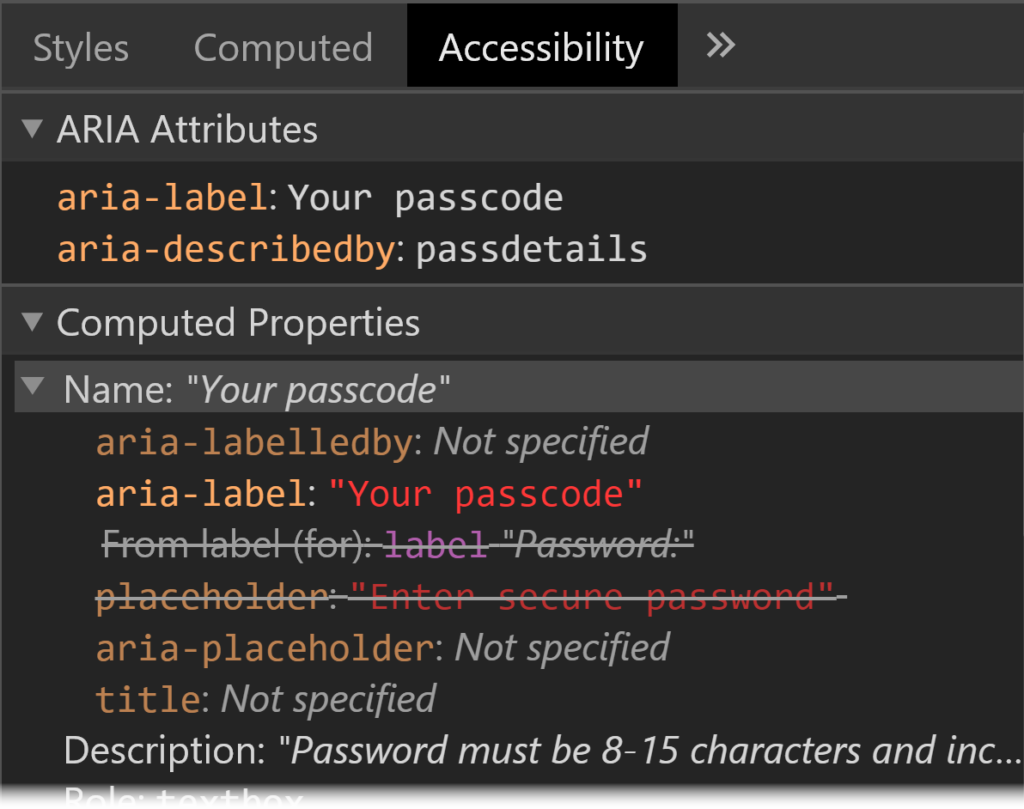Welcome to your monthly frequent11y newsletter, brought to you by @ChrisBAshton. I hope you enjoy these a11y articles I’ve collated and summarised for you. (Psst – if you find these emails too long, consider switching to shorter, more frequent updates). Now on with the show!
How to Create Accessible Cooking Videos
- Article describing what to do as a content creator to make your videos accessible. It pertains to cooking, but could equally be applied to most videos. 1: provide captions, either via sidecar caption file or embedding directly into video. 2: describe visual elements via a separate audio description track, which is difficult because many players don’t natively support it. For cooking videos, describing while you go should be sufficient. Here’s a good example.
These volunteers are making Black Lives Matter videos accessible to deaf activists
- A group of volunteers on Twitter noticed that many Black Lives Matter videos were missing captions, so they set up @ProtestAccess. Users can tag this account to ask for transcriptions of a video, which over 250 people are on hand to transcribe. Since starting in June, they’ve posted over 500 captioned videos, whilst encouraging the original uploaders (especially large organisations) to provide captions from now on.
44×44 Pixel Cursor Bookmarklet
- This tool by Jared Smith is well worth bookmarking. Click it to turn your cursor into a 44×44 pixel square, to make it easier to test your site against WCAG’s Target Size and Pointer Target Spacing rules.
How Animal Crossing: New Horizons Players Use The Game’s Customization To Make It More Accessible
- Blind athlete Ross Minor navigates the Animal Crossing world by hearing; the sound of your character’s footsteps stops if you walk into an obstacle, and you can use noisy waterfalls and tiki torches to signpost areas of your village. Shannon Natale set up a sign for her aunt, asking players to come close to her aunt’s character before attempting to chat, so that messages are centered in the most visible part of the screen. Some features are still inaccessible, such as insects making no noise: there is a petition to get these fixed.
Autonomous vehicles should benefit those with disabilities, but progress remains slow
- An MIT report estimates that autonomous vehicles might not hit the streets for another decade. The benefits when they arrive, however, will be massive for the disabled community. In the USA alone, it would enable employment for 2 million people with disabilities, while saving $19 billion annually in missed medical appointments. It could also have resulted in 3 million more people voting in the 2012 US election. Anthropologist Megan Strickfaden is advocating for a standard, universally designed autonomous vehicle with side entry ramp so that everybody can access it regardless of ability.
- “This is a unique opportunity in history to vastly improve the lives of millions of people with disabilities. All of us will grow old, if we are fortunate to live long lives, and many of us will need, either permanently or temporarily, the assistance that [autonomous vehicles] afford” ~ Sheryl Gross-Glaser, director of the nonprofit Community Transportation Association of America.
Operating System and Browser Accessibility Display Modes
- Eric Bailey summarises several global settings users might use to change their display, the reason for their existence and the effect they can have on your website. The modes are Dark, Increased Contrast, Inverted Colors, Reduced Motion, and High Contrast. He also describes how to target them in code, so that you can better tailor your site to your users. A very useful resource.
When there is no content between headings
- This is a question that often comes up: are you allowed to have a heading immediately followed by another heading, with no content in between? Hidde de Vries gives us a useful rule: “Always have content between headings of the same level.” I.e. a
<h2>immediately followed by a<h3>is fine, but a<h2>followed by a<h2>is not.
- Suzanne Aitchison created this site to help share the a11y knowledge she has curated over the years as a software developer. It covers fundamentals, but also there’s a specific section covering a11y in Single Page Applications, which can otherwise be quite hard to find resources for. Well worth a look.
Decoding Label and Name for Accessibility
- Consider the following HTML:
<label>Name: <input aria-label="First name" placeholder="e.g. Chris" title="Enter a name"></label>. What gets read out by screen readers? - Answer: the
aria-labelalways takes priority. In its absence, it would be thelabel, and in the absence of that, thetitle, or if nothing else, theplaceholder. These rules are defined in the HTML Accessibility API Mappings’ Accessible Name and Description Computation. Browsers have built-in tools to allow you to inspect an element’s accessibility properties.

6 webinars from GDS to improve accessibility within your organisation
- A curated list of videos from the Global Accessibility Awareness Day (21 May 2020): Introduction to the Public Sector Bodies accessibility regulations (34m), How to make your PDFs accessible (17m), How to engage your workforce on accessibility (16m), How to avoid common accessibility statement fails (42m), How to carry out basic web accessibility checks (58m), How to build digital services that work for everyone (30m).
Typing With One Hand on Your iPhone Just Got a Little Easier

- As iPhones get bigger, it can be harder to reach certain keys on your keyboard when using just one hand. Apple have built a “One-Handed Keyboard” mode, which squashes the keys together and makes it easier to reach any given key with your thumb. To enable: when using the keyboard in any app, press and hold the globe icon in the bottom left corner and choose “Keyboard settings”, then switch to right-handed or left-handed keyboard.
What to look for in an accessibility audit
- A blog post by Glenda Sims, describing Deque’s different audit offerings. Clients need to choose the browsers and assistive technologies included in the audit, though this needs to be balanced against the cost of testing. Pragmatically, Glenda claims that using Chrome with NVDA will catch >90% of accessibility issues. Clients also need to choose which pages to test, which should include the site’s entry points, core paths and highest traffic pages. Lastly, they must choose what standard to test against: usually WCAG 2.1 Level A (lowest level of conformance) or AA.
Five Things I Use My Phone For On A Daily Basis
- Luke Sam Sowden, who is “Severely Partially Sighted”, describes how he uses the accessibility features of his iPhone XR, and apps. He uses Microsoft Seeing AI, Tap Tap See and Digit-Eyes to use his phone’s camera to recognise objects, people and text in his surroundings. Google Maps gives good directions. The built-in Camera App is VoiceOver-compatible and tells him where his face is on the screen if he’s trying to take a selfie. Finally, he finds Twitter and Instagram quite accessible – the latter is improving with “Photo descriptions” and Instagram Stories.
AudioEye Sues AccessiBe for Patent Infringement
- AudioEye is suing accessiBe for allegedly using tech that AudioEye has a U.S. patent on (patent no. 10,762,280). Both companies are involved with accessibility. accessiBe announced 12 million dollars of funding in May 2020. The article laments the fact that one a11y-focussed company is suing another, and wishes the money was spent improving the lives of disabled people instead. You can read the legal filing by AudioEye, but I’m inclined to agree that it’s a waste.
GDS updates its Government Service Standard requirements for assistive technology (AT) testing
- Other than updating version numbers of AT and browser combinations, the main changes are: adding TalkBack (Android screen reader); reducing magnification level to test in from 10x to 4x; swapping ZoomText with Windows Magnifier or Apple Zoom; and specifying VoiceOver should be tested in iOS (testing in macOS is in a new ‘optional’ list for further testing).
- There’s also a helpful note about it being good to test with any screen reader, speech recognition tool or screen magnifier in your development environment, but that you should test against the full list prior to launch.
alt attributes like paragraphs
- Developer and accessibility expert Dave Rupert came to a realisation recently: “
alttext is like a paragraph”. To clarify, Dave isn’t talking about the length of thealttext here, but the order in which it appears, and its contextual relevance. A lot of designs have images appearing before headings, but screen reader users who navigate by headings would miss the image (andalt) entirely. If the image is important (e.g. “Sale” or “New”), it should probably be moved below the heading in the source order, but then perhaps rendered above the heading using something like the CSSorderproperty.

- This is a WCAG 2.1 compliant date picker, from the Duet Design System, that also allows you set a minimum and maximum allowed date. It can be used standalone or incorporated into any JavaScript framework, and weighs 10kb minified and Gzip’ed. It supports modern browsers and screen readers, and has limited support for IE11.
10 Things to Know About Twitter’s Alternative Text for Images
- Article by Deborah Edwards-Oñoro, summarising a few things you may not know about alt text for images in tweets. Alt text is now enabled by default on the web and apps (no need to turn on image descriptions in settings). Alt text cannot be added to already published tweets. It can be added to animated GIFs. You can use up to 1000 characters for alt text. If you leave it blank, Twitter will add “Image” as the alt text.

Are clear masks the way to clearer communication? The deaf community isn’t so sure.
- Yahoo! article by Abby Haglage, explaining that clear face masks may not be the panacea we think it is for the deaf community. The masks can fog up, reducing visibility – and even if that is put aside, lip reading is only about 30% effective. Many advocates are encouraging people to learn some BSL (British Sign Language) instead. However, Abby acknowledges that clear masks are a step in the right direction.
Whew, that was a long newsletter! Did you know that you can subscribe to smaller, more frequent updates? The dai11y, week11y and fortnight11y newsletters get exactly the same content. The choice is entirely up to you! Curated with ♥ by developer @ChrisBAshton.